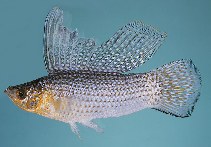| Family: |
Poeciliidae (Poeciliids), subfamily: Poeciliinae |
| Max. size: |
15 cm TL (male/unsexed); 10 cm TL (female) |
| Environment: |
benthopelagic; freshwater; brackish; marine; depth range - 0 m, non-migratory |
| Distribution: |
North America: Cape Fear drainage in North Carolina, USA to Veracruz, Mexico. Introduced to many countries. Several countries report adverse ecological impact after introduction. Gulf of Mexico (Ref. 26938). |
| Diagnosis: |
The large sail-like dorsal fin of the male is the most distinctive characteristic of this fish; coloration can vary from green, gray to jet black; speckled forms also common (Ref. 44091). |
| Biology: |
Found in still or gently flowing warm water of small creeks and drains (Ref. 44894). Occurs in ponds, lakes, sloughs, and quiet, often vegetated, backwaters and pools of streams (Ref. 5723) and also in coastal waters (Ref. 7251). Abundant in tidal ditches and brackish canals. Feeds mainly on algae (Refs. 7251; 44091), also consumes animal material: rotifers, small crustaceans (such as copepods and ostracods) and aquatic insects (Ref. 79012). |
| IUCN Red List Status: |
Least Concern (LC); Date assessed: 03 February 2019 Ref. (130435)
|
| Threat to humans: |
potential pest |
Source and more info: www.fishbase.org. For personal, classroom, and other internal use only. Not for publication.
